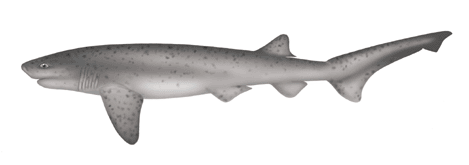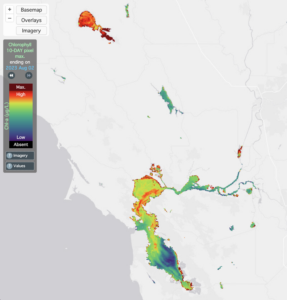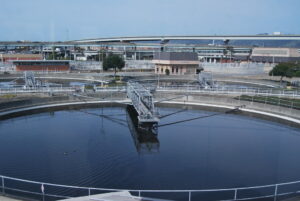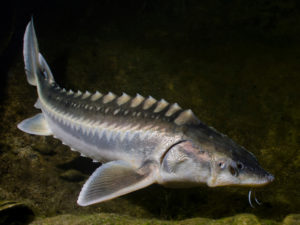Every day, thousands of people drive to work over one of the six bridges that span San Francisco Bay. Looking down at the Bay, bridge travelers can see only the opaque gray-green surface of the water. From that perspective, it is easy to overlook the Bay’s vibrant diversity. In fact, the Bay is a rich ecosystem teeming with life and drama. If the waters were crystal clear, as in a giant aquarium, commuters would be treated to the sight of sharks and other fish swimming through the water, as well as sea stars, crabs, tunicates, worms, and dozens of other species resting and crawling on, or burrowing into, the muddy bottom
The relatively warm, shallow-water and nutrient-rich environment of the Bay makes it ideal habitat for bottom-dwelling and bottom-feeding organisms. These organisms then serve as food for the smaller, inshore sharks who, in turn, attract the larger sharks that prey on them. In this muddy underwater world, the large sharks are the top predators.
Because I grew up fishing along the shoreline in San Leandro, I had long been aware of the abundance of sharks and rays in the Bay. But even after becoming a naturalist with the East Bay Regional Park District, I still didn’t know much about them, nor did I consider them a major feature of the Bay Area’s fauna.
In July and August of 1967, nearly 1,000 sharks beached themselves or washed ashore along the Alameda shoreline, including Crown Beach. The live sharks were returned to the water by District staff, only to beach themselves again and again. Was this strange behavior caused by some form of pollution, or by a naturally-occuring disease or parasite? None of the experts or technical literature seemed to offer a satisfactory explanation. My curiosity piqued, I decided to undertake a research project focusing on sharks in San Francisco Bay.
Since that time, I have worked with other scientists to examine over 4,000 sharks that we captured on long lines set across currents in different parts of the estuary. By counting, measuring, and examining these sharks, we have assembled a fairly comprehensive database on the inshore sharks of the Bay. There is still much we do not know about these top marine predators, including the causes of the 1967 beaching and subsequent smaller die-offs. But from our studies, and those of others, a picture has emerged of the Bay as a rich and complex estuarine ecosystem that serves as a major shark nursery. The shark population, numbering in the hundreds of thousands, consists primarily of five species: leopard shark, brown smoothhound shark, spiny dogfish, sevengill cowshark, and soupfin shark.
While our studies have not found evidence of a significant decline in overall shark numbers in the Bay, there continue to be serious threats to our local shark populations, including fishing and pollution.
Following the spectacular success of the movie Jaws in the late 1970s, interest in shark sportfishing skyrocketed. While the more popular game sharks—such as great whites and makos—are not found in San Francisco Bay, shark sportfishing in the Bay has become popular as an alternative to angling for salmon, halibut, and rockfish when ocean waters are rough. Given the increased popularity of shark meat amongst consumers, commercial and recreational fisherman now target leopard sharks, which in the past were regarded as “trash” fish. These developments have prompted new concern for the survival of this species.
Pollution is another problem. When sharks feed on bottom-dwelling species such as clams, shrimp, and crab, heavy metals and chlorinated hydrocarbons—which bind to sediments in the Bay—get transported up the food chain. Dredging, which disturbs Bay muds and causes the sediments to be temporarily suspended throughout the water column, poses a potential danger to sharks and other fish that swim through the suspended particles. We know that the sharks examined in the 1967 die-off had elevated levels of heavy metals and chlorinated hydrocarbons in their tissues, but we were not able to correlate these higher levels with their aberrant behavior.
Indeed, it is surprising how much we still don’t know about the sharks in the Bay. This is due, in no small part, to the muddiness of the water, which inhibits direct observation, either from above or below the surface. (The murkiness presents no such problem for the sharks, who have an electrical field detection system—called the “ampullae of Lorenzini”—and an excellent sense of smell.) We lack solid information on the total numbers of resident sharks in the Bay. We don’t know what their normal lifespans in the wild are. We don’t understand how and why they come together in large, size-specific groupings, nor how long these groupings persist. And we know very little about the movement of the different shark species between the Bay and ocean waters, and between this and other areas along the coast.
What we do know is that sharks are an integral part of the overall ecology of the Bay and ocean, as well as a prime indicator of the richness of this estuary. As high-level predators who regulate the populations of lower level organisms, their presence is essential to the health and balance of these marine ecosystems. Right below the lanes of traffic on the San Mateo Bridge, there exists a complex and dynamic underwater world ruled by organisms that evolved over 300 million years ago. An awareness of their presence—combined, perhaps, with a healthy dose of awe and wonder—could go a long way toward ensuring that these magnificent animals continue to flourish alongside us for years to come.
San Francisco Bay Sharks
Leopard Shark
With its off-white skin sporting black or charcoal-gray spots and bars, the leopard shark (Triakis semifasciata) is one of the most beautiful sharks in the Pacific. It is also the most abundant shark in the Bay. While leopards have been reported to reach six feet in length, such specimens have not been observed in the Bay for many years, due to the cumulative effects of over-fishing.
Leopards spend considerable time on or near the bottom of the Bay, and most of the food they capture is at, or just beneath, the surface of the bottom mud. Indeed, leopard sharks have been observed thrusting their faces into the mud to capture a buried shrimp or to tear off the upper section of a large clam’s neck. Other prey include crabs, innkeeper worms, small fishes, and herring and smelt eggs. Unlike other species of Bay sharks, who must swim continuously to breathe, leopards have the ability to sit on the bottom and pump water through their gills with their lower jaws.
Leopards in the Bay often feed and move about in loose size-related aggregations, where the length variation from the smallest to the largest is less than 12 inches. We have caught up to 70 individuals of a single species on a single line, but we have no way of knowing how many others were also in the immediate area at the same time.
Leopard sharks mate in June and July, congregating en masse in and around the Bay’s tidal salt marshes. About nine months later, up to 36 six- to eight-inch pups are born in and near marsh channels, primarily in the South Bay. Those pups that survive eventually move out from the sloughs into the open water of the Bay. There, they become vulnerable to sevengill sharks, larger fish, seals, and sea lions.
-
Sevengill cowshark. Illustration by Mathew Squillante.
In the waters of San Francisco Bay, the deceptively slow-moving, but powerful, sevengill cowshark (Notorynchus cepedianus) is the top marine predator. It feeds mostly on smaller sharks, as well as on other fishes and young harbor seals. It is named for the seven gill slits on each side of its head. (Most other sharks have five gill slits on each side.) The sevengill reaches 10 feet in length and can exceed 250 pounds.
Sevengills are masters of stealth and constantly test the water for electrical pulses from potential prey; once the signal of a distressed or feeding shark has been picked up, the black-speckled, gray body appears to come out of nowhere. These opportunistic hunters will routinely take advantage of any shark caught on a fishing line or focused on feeding. In the course of our research, we have pulled up long lines set over deep-water channels patrolled by sevengills, only to find well over half of the hooks sporting little but the heads of the smaller prey sharks. Sevengills have even been observed attacking mating leopard sharks in narrow, shallow marsh channels. While no attacks on people have been documented in open water, sevengills held in captivity have attacked divers.
Although sevengills are found in temperate seas of both the Pacific and southern Atlantic oceans, they are most common along the Pacific Coast in Humboldt, Tomales, and San Francisco bays, which serve as primary nurseries for the species. Large individuals generally patrol the deep-water channel in the South Bay, as well as other deep areas of the Bay. Their newborn offspring, however, are found in the shallows near marshes. The 17-inch long sevengill pups are born in late spring or early summer, timed to coincide with the birth of their main prey—the pups of other shark species.
Brown Smoothhound Shark
The more diminutive brown smoothhound (Mustelus henlei) rarely exceeds 36 inches in length. As its name implies, this shark has a bronze to reddish-brown cast to the upper part of its body. It is the second most abundant shark in the Bay and, like the leopard, is a year-round resident. Also like the leopard, smoothhounds congregate in loose groupings as they cruise near the bottom of the shallow inshore waters of the Bay, feeding mostly on crabs, shrimp, worms, and small fish. Unlike leopard sharks, however, they do not rest on the bottom. They generally do not frequent the deeper channel areas of the Bay where large sevengills hunt.
Like other sharks, smoothhounds have skin composed of miniature teethlike structures, called denticles, which point toward their tails. Unlike the scales of bony fish, denticles do not have a slimy coating, but their structure and small size serve to reduce drag from the water on the shark as it moves forward.
Smoothhounds mate in June and July, giving birth to their 6-12 pups in March and April, in the shallow, open water areas near shore. The newborn, eight-inch-long smoothhounds are often eaten by sevengill pups that inhabit this inshore zone. The adults are preyed on by sea lions, which will occasionally toy with their victims, tossing them out of the water several times before ingesting them whole, headfirst.
Spiny Dogfish
The spiny dogfish (Squalus acanthias), the third most abundant shark species in San Francisco Bay, is one of those cosmopolitan species found both in the Atlantic and Pacific oceans. The most notable feature of this three-foot-long shark is the single, calcified spine in front of each of the two dorsal fins. It is believed that this needle-sharp spine serves to hold the fin rigid during turning maneuvers. Spiny dogfish are also distinguished by the white spots on their gray bodies and by their large, green, opalescent eyes.
Similar to the leopards and smoothhounds, dogfish have been observed to travel around the Bay in loose, size-related aggregations. Also similar to the leopards and smoothhonds, dogfish use the Bay as their nursery in spring. Dogfish have evolved a special birthing procedure to ensure that their backward-pointing spines don’t get caught on the edges of the mother’s vent. Initially, as the embryos develop inside each of the mother’s paired uterine canals, they face forward inside their own membranous egg-sacs. Before birth, however, the pups will turn 180 degrees, break through the membrane, and emerge headfirst. Dogfish reproduction is anomalous in other ways as well. At 24 months, spiny dogfish have by far the longest gestation period of any Pacific coast shark; other Bay Area sharks have gestation periods of a year or less. Dogfish females do not reach sexual maturity until they are 20 to 25 years of age.
The dogfish feeds on crabs, small octopus, fish, and fish eggs. The enormous annual production of herring and smelt eggs in the Bay are a critical component of the diet for all of the small Bay sharks, including the dogfish.
Soupfin Shark
The soupfin shark (Galeorhinus zyopterus) is a transient in the Bay, entering in the spring for breeding and birthing; they are not found in the Bay during the fall and winter months. The soupfin gets its name from its comparatively large fins. Prior to the 1960s, soupfins were prized by commercial fisherman, who cut off the large fins and dried them for use in soup.
Blue-gray to dark gray, these 60-inch sharks have extremely sharp teeth—which they use to catch their prey, as well as to cut through the monofilament lines of fishermen and researchers. This ability means that their numbers may have been underrepresented in shark counts in the Bay. However, we do know that they generally enter the Bay in the spring to give birth to as many as 52 14-inch pups. Breeding follows soon thereafter. By late summer, the soupfins have returned to the open ocean. In ocean waters, the soupfin sharks segregate by sex: male soupfins are more dominant in Northern California waters, whereas females are more abundant off Southern California. The Bay is one of the few areas along the California coast where male and female soupfins are found together. The soupfin is an opportunistic feeder, consuming herring, flounder, rockfish, mackerel, and squid, among other prey.

.jpg)




